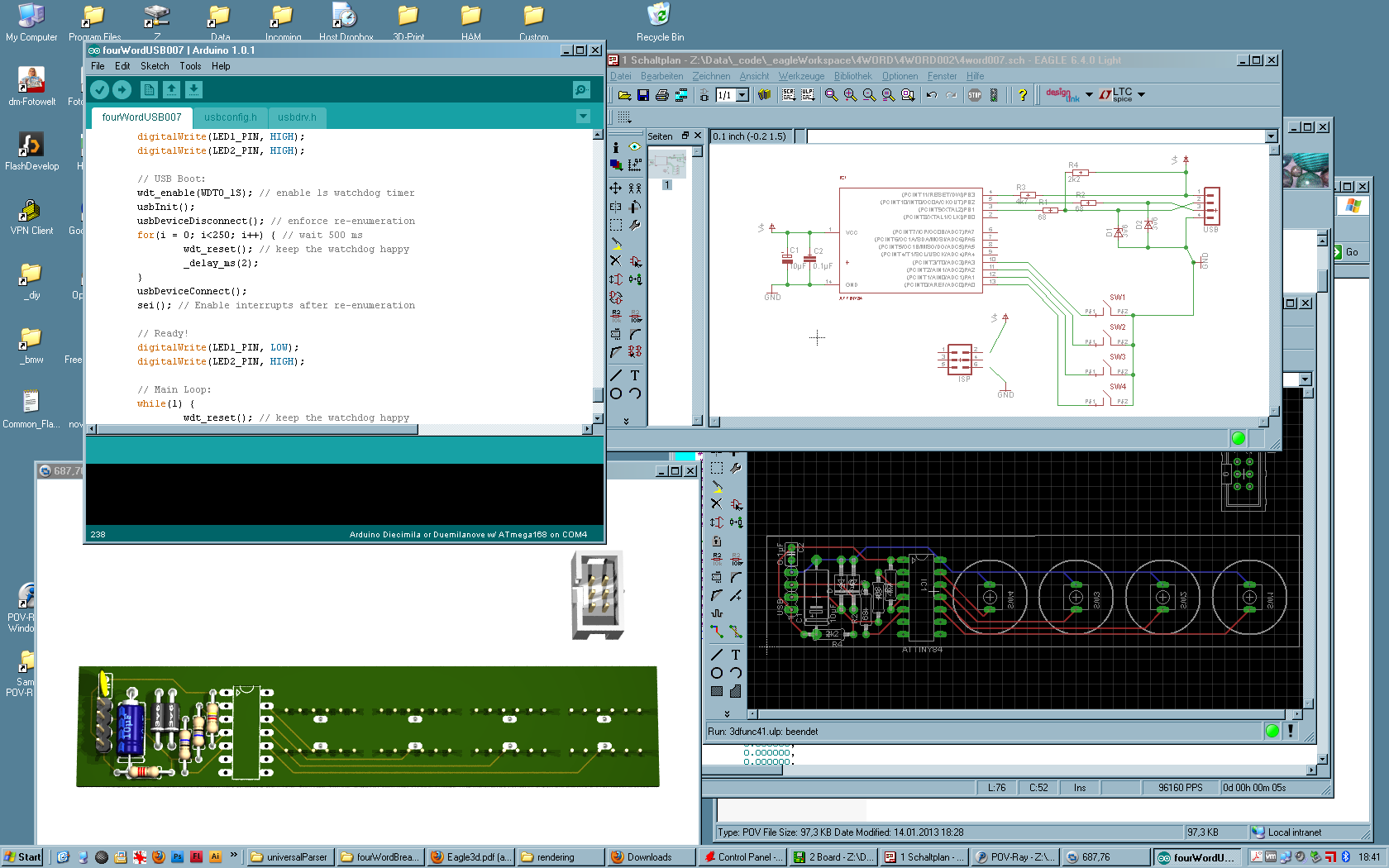Sketching with Hardware
Day 2
GIF by Robin Davey, http://robindavey.co.uk/
Course Overview
| 1 | Monday | Fundamentals, Keyboard Hacking, Experiments |
|---|---|---|
| 2 | Tuesday | Arduino, Project Topic |
| 3 | Wednesday | Brainstorming Day |
| 4 | Thursday | Own Project |
| 5 | Friday | Own Project |
| Saturday | — | |
| Sunday | — | |
| 6 | Monday | Own Project |
| 7 | Tuesday | Final Presentation, Wrap Up |
Day 2
| 09:00 | Arduino Introduction |
|---|---|
| 10:00 | Analog IO |
| 11:00 | Sketching Circuits |
| 12:00 | Break |
| 13:00 | More Sensors |
| 14:00 | Whatever you like |
| 15:00 | Introduction to our Topic |
| 16:00 | Brainstorming Ideas |
"Hello, Computer!"
II
Quelle: UTEXAS
Arduino

Image Source: ArduinoArts
Arduino — Connected

Image Source: SirLeech
Arduino provides (some) power
Arduino provides (some) power
Digital Input/Output
Digital Output
Blinking LED
void setup() {
pinMode(12, OUTPUT); // Make pin an output for us
}
void loop() {
digitalWrite(12, HIGH); // Set pin to be "+" (on)
delay(500);
digitalWrite(12, LOW); // Set pin to be "-" (off)
delay(500);
}
Digital Output
High Load!
Digital Output
Transistor / MOSFET
Digital Output
Transistor / MOSFET
Digital Output
Transistor / MOSFET
Digital Input
Pull a pin "up" (+)
void setup() {
pinMode(2, INPUT); // Make pin an input for us
}
void loop() {
value = digitalRead(2); // Read what's on that pin
}
Digital Input
Pull a pin "down" (-)
void setup() {
pinMode(2, INPUT); // Make pin an input for us
digitalWrite(2, HIGH); // Activate internal pull-up
}
void loop() {
value = digitalRead(2); // Read what's on that pin
}
Digital Input
Using a Bread Board
Analog Input/Output
Arduino Analog Input

int potPin = 2; // select the input pin for the potentiometer
int ledPin = 13; // select the pin for the LED
int val = 0; // variable to store the value coming from the sensor
void setup() {
pinMode(ledPin, OUTPUT); // declare the ledPin as an OUTPUT
}
void loop() {
val = analogRead(potPin); // read the value from the sensor
digitalWrite(ledPin, HIGH); // turn the ledPin on
delay(val); // stop the program for some time
digitalWrite(ledPin, LOW); // turn the ledPin off
delay(val); // stop the program for some time
}
Analog Output
PWM — Pulse Width Modulation

Analog Output

Analog Output: Servo

- PWM freq is 50 Hz (i.e. every 20 ms)
- Pulse width ranges from 1 to 2 ms
- 1 ms = full anti-clockwise position
- 2 ms = full clockwise position
Analog Output: Servo

Analog Output: Servo

"Servos, Oida!" ☺

Analog Output: RGB LED

Pins: R G − − B B
GND = Cathode = −
Motor ansteuern
Sketching Circuits
CircuitLab

Circuit Simulator

EAGLE

Fritzing

More Sensors
- Light
- Temperature
- Distance (Infra Red, Ultra Sonic)
- Magnetic Sensors (Reed, Hall-Effect)
Actuators
- Motors
- Servos, Steppers
- Speakers
- Solenoids
- LEDs (RGB)
- Piezos
Topic ...
Topic:
IooT
Internet of old Things
Image Source: OX Blog
Features
- Give old things some modern functions!
- Make things communicate!
- Think Steampunk!
Image Source: Business Korea
Hardware
- Microcontroller: Arduino UNO/MEGA
- WiFi: ESP8266
- Bluetooth: HC-05
Recommended Search Terms
- IoT
- Hacking
- DIY
Brainstorming!
GIF by Robin Davey, http://robindavey.co.uk/
Brainstorming!
- Project Name
- Main Idea
- Features
- Sensors? Actuators?
- Software? Complexity? Costs?
- Plan B?
Raus an die frische Luft!
Image Source: Heinrich Kopp: KinderreigenHomework: Elaborate.
- Present your final ideas tomorrow.
- Don't forget to document everything!